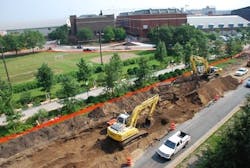In the early 1900s, public transportation in Minneapolis and St. Paul consisted of streetcars and, later, buses. When residents began buying cars, transit services gradually decreased, cities pulled out rails, and municipalities paved streets to serve cars. Trains also provided quick and easy transportation, but passenger service declined with the push to own cars until the government created Amtrak in 1974 to take control of all U.S. passenger service.
Public transportation appeared to be in jeopardy as more people owned more cars. However, one issue that faced car owners became increasingly difficult to manage: traffic gridlock. Once again, public transportation became a solution.
Today, Minnesota’s two largest cities are undergoing construction for an 11-mile light rail service that will begin in 2014. The idea and planning began in 1981 in Ramsey County, covering St. Paul, which later gave the project to the Metropolitan Council, the planning authority for seven counties in and surrounding the Twin Cities.
Stakeholders sign agreement
With two cities, two counties, the Department of Transportation, State of Minnesota, University of Minnesota and the Metropolitan Council signing agreements on this project, construction work began in September 2009. Four major contracts cover the construction of the entire line with the Civil East package covering St. Paul’s construction and the Civil West package covering the Minneapolis construction to include street work, utility work, bridge work, all stations and track work.
Carl Bolander & Sons, St. Paul, was hired to start work on St. Paul’s Fourth Street and excavated five blocks to relocate utility lines under the portion of Fourth Street where rails will be built. About 65,000 cubic yards of soil was removed as Bolander used its hydraulic excavators, including a Caterpillar 245, Komatsu PC308USLC, Komatsu PC228USLC and John Deere 350D on this section.
“Any public utility that requires moving is in the contract for us to manage,” said Chris Weyer, assistant director for Construction, Central Corridor Light Rail Transit project. “Private utilities, by state statute, move their lines at their expense. We coordinate with them to facilitate our work.” Also under Fourth Street are District Energy heating and cooling pipes, water mains, and other utilities that required relocation.
Relocate utilities
“Light rail can’t have utilities under it because if that public or private utility has to have work done underground, we can’t stop train service and excavate under the tracks. We moved utilities lines to other locations or they’re outside of the track section,” Weyer said.
At one point, Bolander excavators struck brick pavers and a general fill that was from very old excavation techniques as they continued digging to lower levels, said Mark Ryan, president at Bolander. After Bolander completed utility work, Graham Construction Services, Eagan, paved the north side of Fourth Street with concrete and FPI Paving used asphalt to pave the remaining areas.
In 2010 Graham Construction Services prepared streets on the East Bank of the University of Minnesota to accommodate additional traffic. Washington Avenue, along a section of the University’s retail area and Radisson Hotel, will close permanently to vehicles beginning this summer and new sidewalks and streets will be built. Graham Construction excavated 30,000 cubic yards of dirt to install a storm sewer and a water main in the area.
Construction at the “U”
Mark Fisher, senior project manager at Graham Construction, said his workers hauled over 7,000 tons of contaminated material that had to be disposed. After excavation, workers installed 600 feet of 48-inch HDPE pipes for a future storage basin at a new University building.
Graham Construction’s work began last May and finished by Labor Day to allow students and staff to use new sidewalks and streets.
In mid-May 2011, when classes end at the University, the Ames Construction-C.S. McCrossan Joint Venture will begin converting Washington Avenue into a transit and pedestrian mall for the Central Corridor LRT trains, buses, cyclists and emergency vehicles. The area will not be open to traffic and, as cars travel east across the Washington Avenue Bridge, they will be diverted either north or south to connect to other streets.
Walsh Construction, Chicago, is under the Civil East contract to excavate and relocate utilities on University Avenue from the border of St. Paul and Minneapolis to the Union Depot in downtown St. Paul. Weyer said workers were removing snow on the road to prepare for excavation. “They have to go below the street and rebuild the water main first to provide water service. Walsh will put in temporary water pipes while they relocate utilities, then install permanent pipes and remove the temporary pipes.
Work in road segments
“Any utility that is below the road where tracks will be built must be relocated or updated as Walsh works in road segments. Then they move on to the next segment and do the same thing,” said Weyer. “Workers will rebuild the street section for traffic on the outside lanes in each direction and will provide a section on the inside lanes to install the embedded tracks.”
Asbestos abatement work began to renovate the former Diamond Products building, now vacant, into the maintenance and operations building. The 14,000-square-foot building, on the eastern edge of downtown St. Paul, received $41 million for building renovations that will provide equipment for light maintenance and car storage. When PCL Construction completes the abatement and cleaning hazardous materials, general demolition begins in selected areas to meet design specifications.
Through 2013, work will be scattered throughout the 11 miles to prepare streets for the new tracks. Some intersections will be reconstructed, contractors will prepare for electrical and communication power, and Bremer Bank in St. Paul will be demolished. For information on the Central Corridor, go to www.centralcorridor.org.
